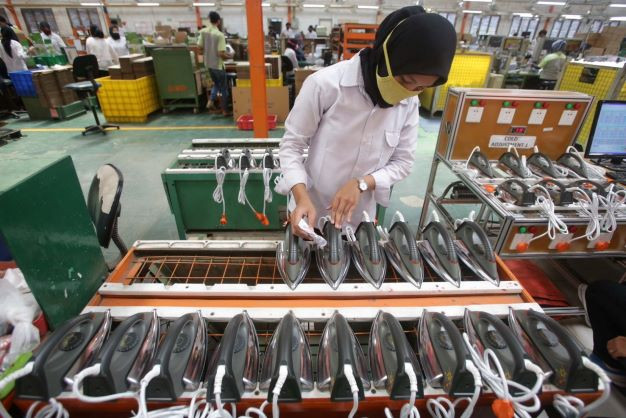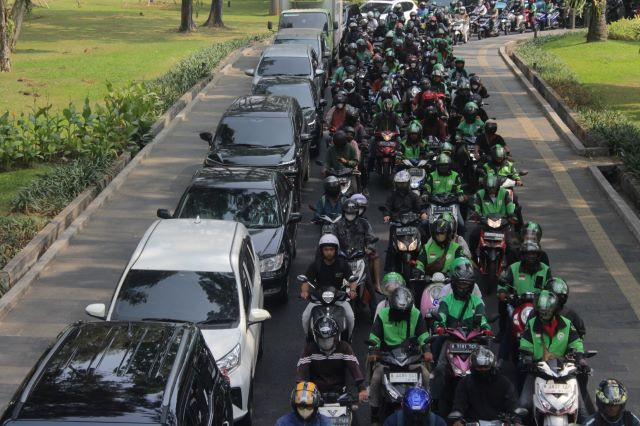Popular Reads
Top Results
Can't find what you're looking for?
View all search resultsPopular Reads
Top Results
Can't find what you're looking for?
View all search resultsIndonesia’s economy under global perfect challenge
From an international economic perspective, cooperation with close economic partners is essential to secure Indonesia's economic resiliency.
Change text size
Gift Premium Articles
to Anyone
Statistics Indonesia (BPS} reported last Friday that Indonesia’s economy grew by 5.44 percent year-on-year in the second quarter. That growth rate was quite remarkable compared to the 7.07 percent expansion in the same period last year, especially if the growth was set against the 3.79 percent inflation in the second quarter.
Indonesia's Consumer Confidence Index (CCI) experienced an initial pick-up in the second quarter of 2022, rising from 113 in April to 128 in June, showing that Indonesia's consumption confidence had kept rising despite climbing global and domestic inflation. This should be attributed to the decrease in the COVID-19 infection rate in the second quarter, which in turn significantly eased social-mobility restrictions, thereby bolstering economic activities and household consumption, especially during the Islamic Ramadan and Idul Fitri festivities.
Household consumption, which usually accounts for over 51 percent of GDP, grew by 5.51 percent in the second quarter. The perfect combination of higher-production growth in the first quarter and strong household consumption in the second quarter helped build up strong buffers for Indonesia in facing the perfect challenge of global economic crises. The perfect challenge combined a global pandemic and the war in Ukraine that simultaneously decreased aggregate demand and supply.
The combined figure for economic growth and the inflation rate in the second quarter showed that optimism in Indonesia's economy kept increasing from the first to the second quarter. If the production side played the engine of growth in the first quarter, then consumption expenditure took the role as the growth driver in the second quarter.
The growth of the manufacturing sector declined to 4.01 percent in the second quarter, which was lower than the GDP growth rate, from 5.07 percent in the first quarter. In further detail, Indonesia's PMI Manufacturing Index in the first quarter slightly decreased from 53.7 in January to 51.3 in March.
What made the manufacturing sector exceed national economic growth in the first quarter while the PMI Manufacturing declined? One probable answer is the stable import value and surplus in trade account from US$9.3 billion in the first quarter to almost double at $15.6 billion in the second quarter. The increasing import-value trend and trade-account surplus indicated that economic activities, including production activities, continued to increase.
The Real Broad Effective Exchange Rate (RBEER) is a valuable indicator for analyzing external positions. This indicator combines the relative inflation rate of Indonesia and the United States and the nominal exchange rate of the rupiah and the US dollar. The latter is affected by the current-account position.
The RBEER showed that the Indonesian economy was relatively stable in the first semester. Yet, Indonesia must anticipate decreasing primary-commodity prices that can reduce trade and current account when the domestic inflation-rate increases amid high oil-and-gas prices.
A similar phenomenon was seen in 2013-2014 when decreasing global-commodity prices left Indonesia with a deficit in trade and current account. The domestic inflation rate increased from 4 percent in 2012 to 8 percent in 2013 and 2014.
What can we do to contain the perfect challenge from global economic uncertainty?
First, from an international economic perspective, cooperation with close economic partners is essential to secure Indonesia's economic resiliency. In the regional-plus cooperation framework, the government is attempting to enhance economic cooperation within ASEAN and between Indonesia and its major trading partners of China, Japan and South Korea.
The official visit of President Joko “Jokowi” Widodo to the three East Asia countries of China, Japan and South Korea from July 23 to July 28 amid the increasing global economic uncertainty proves these three countries are important to Indonesia.
The data confirmed that these three countries are Indonesia's major trading partners. They are very close to Indonesia under the regional-economic frameworks of the ASEAN Plus One free trade agreement, ASEAN Plus Three, the Regional Economic Partnership Agreement (RCEP) and the East Asia Summit. Solid economic relations within ASEAN member states and between ASEAN and East Asian countries are essential for cushioning global-economic uncertainty.
Indonesia will chair ASEAN in 2023, and my study in July showed that ASEAN is very strategic because it aims at the long-run perspective of trade and investment integration. This long-run objective fits Indonesia's aim to survive the current global perfect challenge. The enhanced binding within ASEAN Plus countries will make their economies more resilient, agile and strong.
Second, Indonesia's external balance is always better off every time Indonesia faces a crisis. After the 1997 Asian Financial Crisis (AFC), Indonesia's current account shifted from a deficit of -1.7 percent of GDP in 1997 to a surplus of 3.7 percent of GDP in 1998.
In 2008, amid the Global Financial Crisis (GFC), the current account increased from a surplus of 0.04 percent of GDP in 2008 to 1.8 percent of GDP in 2009. In 2020 amid the global C0VID-19 pandemic, Indonesia's current account changed from a deficit of -0.4 percent of GDP 2020 to a surplus of 0.3 percent of GDP 2021.
Indonesia's current-account surplus always compensates for the decrease in other macroeconomic variables such as investment during the AFC 1997 and GFC 2008 and consumption amid the global pandemic 2020. Adam Smith, in 1759, explained how the “invisible hand” manages the market mechanism.
Therefore, economic recovery improves through government efforts and natural support. The Ora et Labora is the real deal in any economic-recovery process.
***
The writer is an adviser on industry and international trade to the finance minister and deputy director of the Institute for Economic and Social Research of University of Indonesia’s School of Economics and Business (LPEM-UI). The views expressed are his own.










